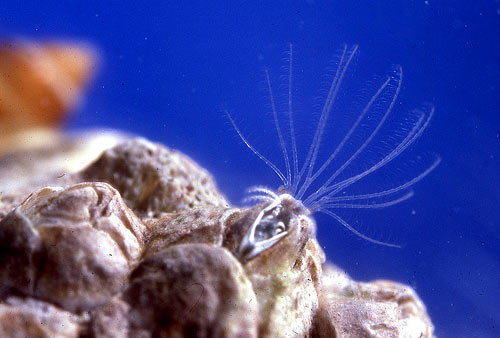-
Notifications
You must be signed in to change notification settings - Fork 1
Biology Research
From trends observed in our initial research, we have decided to take inspiration for our project from real-life creatures. Many of the ones we discovered left a striking impression on us were marine lifeforms, for their otherworldly appearances, fluid movement, and the complex ecological relationships found in different marine enviornments.

Feather Star

Giant Isopod

Comb Jelly

Whale Fall

Barnacle
We decided to focus on the barnacle as a central organism, particularly due to its relationship with its food and with other organisms it shares a habitat with. The barnacle's main source of food is microscopic zooplankton, a general term for a wide variety of animals, protozoa, bacteria, and algae that float along currents and feed many types of other marine organisms. The barnacle has an interesting eating mechanism. It opens part of their exoskeleton, the dynamic plates, like a mouth. From within, it extends its cirri, the hairlike filaments seen above, towards prey that floats toward it, sweeping it into their body. This video shows the normally-hidden cirri in motion, as well as the reaction and movement of its planktonic prey, in this case bioluminescent dinoflagellates.

We also learned about the lifecycle of the barnacle. At first, it is a free-moving nauplius, eventually transistioning to a cypris, searching for and settling on a surface, triggering a metamorphosis into an immobile adult barnacle, with its characteristic calcium-based shell, called the fixed plates. Many sea creatures go through similar processes, like the jellyfish, which also radically changes its appearance and behavior. This could be a direction to examine when considering potential long-term changes happening within our installation.
We also researched trophic cascades, a situation that can happen in a habitat with a food chain of three or more organisms. This paper discusses an oyster-reef habitat, where the habitat complexity disrupted the interactions between the top predator (toadfish), the mid-tier predator (mud fish), and the prey (juvenile oyster). Since the top predator eats the mid-tier predator, the mud fish behavior and proliferation will be negatively affected, and that has a positive impact on the population of the juvenile oysters. This has prompted us to consider the role our audience will play as an outsider to our artifical ecosystem. A more relevant example would be the whelk, barnacle, zooplankton chain. When whelks are around, the barnacles get scared and hide, eating less zooplankton. We plan to use our audience as the whelks.
Other Research (Tech & Society - Max)
Initial Kinetic Sculpture Research
MVP - Personas
MVP - Concept
MVP - Ideas
MVP - Diagrams
MVP - Tech Proposal